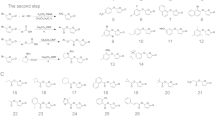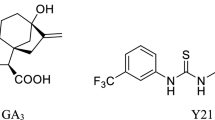Abstract
An N-substituted phthalimide, AC94377, was reported to mimic gibberellin (GA) activity in various plants, and was demonstrated to be a selective agonist for GA receptor GID1 in Arabidopsis, suggesting its potentiality for developing novel GA signal regulators. Here, we confirmed the GA-like activity of AC94377 in rice, including promotion on 2nd leaf sheath growth and suppression on strigolactone exudates from roots. We performed chemical and genetic manipulation of interaction between rice GA receptor GID1 and phthalimides. Our results showed that modifications of carboxamide moiety of AC94377 can interchange the preference for different GID1-subtype. To summary, our findings confirmed universal roles of AC94377 as a GID1 agonist, and the potentiality of designing novel GA agonist or even antagonist based on the scaffold of AC94377 coupled with GID1 manipulations in crops, which could be used for root parasitic weed control.





Similar content being viewed by others
References
Chandler PM, Harding CA, Ashton AR, Mulcair MD, Dixon NE, Mander LN (2008) Characterization of gibberellin receptor mutants of barley (Hordeum vulgare L.). Mol Plant 1:285–294. https://doi.org/10.1093/mp/ssn002
Donald WW (1985) AC-94,377 for breaking dormancy of wild mustard seed in soil. Farm Res 43:28–31
Helander JDM, Vaidya AS, Cutler SR (2016) Chemical manipulation of plant water use. Bioorg Med Chem 24:493–500. https://doi.org/10.1016/j.bmc.2015.11.010
Hirano K, Nakajima M, Asano K, Nishiyama T, Sakakibara H, Kojima M, Katoh E, Xiang H, Tanahashi T, Hasebe M, Banks JA, Ashikari M, Kitano H, Ueguchi-Tanaka M, Matsuoka M (2007) The GID1-mediated gibberellin perception mechanism is conserved in the lycophyte Selaginella moellendorffii but not in the bryophyte Physcomitrella patens. Plant Cell 19:3058–3079. https://doi.org/10.1105/tpc.107.051524
Ito S, Umehara M, Hanada A, Kitahata N, Hayase H, Yamaguchi S, Asami T (2011) Effects of triazole derivatives on strigolactone levels and growth retardation in rice. PLoS ONE 6:e21723. https://doi.org/10.1371/journal.pone.0021723
Ito S, Yamagami D, Umehara M, Hanada A, Yoshida S, Sasaki Y, Yajima S, Kyozuka J, Ueguchi-Tanaka M, Matsuoka M, Shirasu K, Yamaguchi S, Asami T (2017) Regulation of strigolactone biosynthesis by gibberellin signaling. Plant Physiol 174:1250–1259. https://doi.org/10.1104/pp.17.00301
Itoh H, Tatsumi T, Sakamoto T, Otomo K, Toyomasu T, Kitano H, Ashikari M, Ichihara S, Matsuoka M (2004) A rice semi-dwarf gene, Tan-Ginbozu (D35), encodes the gibberellin biosynthesis enzyme, ent-kaurene oxidase. Plant Mol Biol 54:533–547. https://doi.org/10.1023/B:Plan.0000038261.21060.47
Jamil M, Charnikhova T, Houshyani B, van Ast A, Bouwmeester HJ (2012) Genetic variation in strigolactone production and tillering in rice and its effect on Striga hermonthica infection. Planta 235:473–484. https://doi.org/10.1007/s00425-011-1520-y
Jiang K, Asami T (2018) Chemical regulators of plant hormones and their applications in basic research and agriculture. Biosci Biotechnol Biochem 82:1265–1300. https://doi.org/10.1080/09168451.2018.1462693
Jiang K, Otani M, Shimotakahara H, Yoon JM, Park SH, Miyaji T, Nakano T, Nakamura H, Nakajima M, Asami T (2017a) Substituted phthalimide AC94377 is a selective agonist of the gibberellin receptor GID1. Plant Physiol 173:825–835. https://doi.org/10.1104/pp.16.00937
Jiang K, Shimotakahara H, Luo M, Otani M, Nakamura H, Moselhy SS, Abualnaja KO, Al-Malki AL, Kumosani TA, Kitahata N, Nakano T, Nakajima M, Asami T (2017b) Chemical screening and development of novel gibberellin mimics. Bioorg Med Chem Lett 27:3678–3682. https://doi.org/10.1016/j.bmcl.2017.07.012
Kamachi K, Yamaya T, Mae T, Ojima K (1991) A role for glutamine synthetase in the remobilization of leaf nitrogen during natural senescence in rice leaves. Plant Physiol 96:411–417. https://doi.org/10.1104/pp.96.2.411
Los M, Kust CA, Lamb G, Diehl RE (1980) Phthalimides as plant-growth regulators. HortScience 15:22–22
Metzger JD (1983) Promotion of germination of dormant weed seeds by substituted phthalimides and gibberellic-acid. Weed Sci 31:285–289. https://doi.org/10.1017/S0043174500069010
Miyazaki S, Jiang K, Kobayashi M, Asami T, Nakajima M (2017) Helminthosporic acid functions as an agonist for gibberellin receptor. Biosci Biotechnol Biochem 81:2152–2159. https://doi.org/10.1080/09168451.2017.1381018
Miyazaki S, Tomita K, Yamane H, Kobayashi M, Asami T, Nakajima M (2018) Characterization of a helminthosporic acid analog that is a selective agonist of gibberellin receptor. Bioorg Med Chem Lett 28:2465–2470. https://doi.org/10.1016/j.bmcl.2018.06.005
Murase K, Hirano Y, Sun TP, Hakoshima T (2008) Gibberellin-induced DELLA recognition by the gibberellin receptor GID1. Nature 456:459–463. https://doi.org/10.1038/nature07519
Nakamura H, Hirabayashi K, Miyakawa T, Kikuzato K, Hu WQ, Xu YQ, Jiang K, Takahashi I, Niiyama R, Dohmae N, Tanokura M, Asami T (2019) Triazole ureas covalently bind to strigolactone receptor and antagonize strigolactone responses. Mol Plant 12:44–58. https://doi.org/10.1016/j.molp.2018.10.006
Ogawa S, Toyomasu T, Yamane H, Murofushi N, Ikeda R, Morimoto Y, Nishimura Y, Omori T (1996) A step in the biosynthesis of gibberellins that is controlled by the mutation in the semi-dwarf rice cultivar Tan-ginbozu. Plant Cell Physiol 37:363–368. https://doi.org/10.1093/oxfordjournals.pcp.a028954
Phillips AL, Ward DA, Uknes S, Appleford NE, Lange T, Huttly AK, Gaskin P, Graebe JE, Hedden P (1995) Isolation and expression of three gibberellin 20-oxidase cDNA clones from Arabidopsis. Plant Physiol 108:1049–1057. https://doi.org/10.1104/pp.108.3.1049
Rademacher W (2016) Chemical regulators of gibberellin status and their application in plant production. Annu Plant Rev 49:359–404. https://doi.org/10.1002/9781119210436.ch12
Rodaway SJ, Gates DW, Brindle C (1991) Control of early seedling growth in varietal lines of hexaploid wheat (Triticum aestivum), durum-wheat (Triticum durum), and barley (Hordeum vulgare) in response to the phthalimide growth regulant, AC-94,377. Plant Growth Regul 10:243–259. https://doi.org/10.1007/Bf00024415
Shimada A, Ueguchi-Tanaka M, Nakatsu T, Nakajima M, Naoe Y, Ohmiya H, Kato H, Matsuoka M (2008) Structural basis for gibberellin recognition by its receptor GID1. Nature 456:520–523. https://doi.org/10.1038/nature07546
Sukiran NA, Pollastri S, Steel PG, Knight MR (2022) Plant growth promotion by the interaction of a novel synthetic small molecule with GA-DELLA function. Plant Direct 6:e398. https://doi.org/10.1002/pld3.398
Sun TP (2011) The molecular mechanism and evolution of the GA-GID1-DELLA signaling module in plants. Curr Biol 21:R338–R345. https://doi.org/10.1016/j.cub.2011.02.036
Takahashi I, Asami T (2018) Target-based selectivity of strigolactone agonists and antagonists in plants and their potential use in agriculture. J Exp Bot 69:2241–2254. https://doi.org/10.1093/jxb/ery126
Takeuchi J, Jiang K, Hirabayashi K, Imamura Y, Wu YS, Xu YQ, Miyakawa T, Nakamura H, Tanokura M, Asami T (2018a) Rationally designed strigolactone analogs as antagonists of the D14 receptor. Plant Cell Physiol 59:1545–1554. https://doi.org/10.1093/pcp/pcy087
Takeuchi J, Mimura N, Okamoto M, Yajima S, Sue M, Akiyama T, Monda K, Iba K, Ohnishi T, Todoroki Y (2018b) Structure-based chemical design of abscisic acid antagonists that block PYL-PP2C receptor interactions. ACS Chem Biol 13:1313–1321. https://doi.org/10.1021/acschembio.8b00105
Takeuchi J, Fukui K, Seto Y, Takaoka Y, Okamoto M (2021) Ligand-receptor interactions in plant hormone signaling. Plant J 105:290–306. https://doi.org/10.1111/tpj.15115
Uchida N, Takahashi K, Iwasaki R, Yamada R, Yoshimura M, Endo TA, Kimura S, Zhang H, Nomoto M, Tada Y, Kinoshita T, Itami K, Hagihara S, Torii KU (2018) Chemical hijacking of auxin signaling with an engineered auxin-TIR1 pair. Nat Chem Biol 14:299–305. https://doi.org/10.1038/Nchembio.2555
Ueguchi-Tanaka M, Ashikari M, Nakajima M, Itoh H, Katoh E, Kobayashi M, Chow TY, Hsing YIC, Kitano H, Yamaguchi I, Matsuoka M (2005) GIBBERELLIN INSENSITIVE DWARF1 encodes a soluble receptor for gibberellin. Nature 437:693–698. https://doi.org/10.1038/nature04028
Umehara M, Hanada A, Yoshida S, Akiyama K, Arite T, Takeda-Kamiya N, Magome H, Kamiya Y, Shirasu K, Yoneyama K, Kyozuka J, Yamaguchi S (2008) Inhibition of shoot branching by new terpenoid plant hormones. Nature 455:195–200. https://doi.org/10.1038/nature07272
Xiang HY, Takeuchi H, Tsunoda Y, Nakajima M, Murata K, Ueguchi-Tanaka M, Kidokoro S, Kezuka Y, Nonaka T, Matsuoka M, Katoh E (2011) Thermodynamic characterization of OsGID1-gibberellin binding using calorimetry and docking simulations. J Mol Recognit 24:275–282. https://doi.org/10.1002/jmr.1049
Yalpani N, Suttle JC, Hultstrand JF, Rodaway SJ (1989) Competition for in vitro [3H]gibberellin A(4) binding in cucumber by substituted phthalimides: comparison with in vivo gibberellin-like activity. Plant Physiol 91:823–828. https://doi.org/10.1104/pp.91.3.823
Yamaguchi S (2008) Gibberellin metabolism and its regulation. Annu Rev Plant Biol 59:225–251. https://doi.org/10.1146/annurev.arplant.59.032607.092804
Yammine A, Gao JL, Kwan AH (2019) Tryptophan fluorescence quenching assays for measuring protein-ligand binding affinities: principles and a practical guide. Bio-Protocol. https://doi.org/10.21769/BioProtoc.3253
Yoon JM, Nakajima M, Mashiguchi K, Park SH, Otani M, Asami T (2013) Chemical screening of an inhibitor for gibberellin receptors based on a yeast two-hybrid system. Bioorg Med Chem Lett 23:1096–1098. https://doi.org/10.1016/j.bmcl.2012.12.007
Acknowledgements
We thank Kenji Tomita (Graduate School of Agricultural and Life Sciences, The University of Tokyo) for NMR analysis. This work was funded in part by the National Natural Science Foundation of China (Grant No. 21907049 to KJ and Grant No. 31911540070 to HG), the Japan International Cooperation Agency (JICA) and JST under a joint program of Science and Technology Research Partnership for Sustainable Development (SATREPS) to TA, a JSPS Grant-in-Aid for Scientific Research (Grant No. 18H05266) to TA, the Guangdong Innovative and Entrepreneurial Research Team Program (Grant No. 2016ZT06S172) to KJ, the Shenzhen Science and Technology Program (Grant No. KYTDPT20181011104005 to KJ, and China Scholarship Council for a PhD scholarship (201908050180) to JW.
Funding
This work was funded by National Natural Science Foundation of China [Grant Nos. 21907049, 31911540070], Japan International Cooperation Agency, Science and Technology Research Partnership for Sustainable Development, Japan Society for the Promotion of Science, Guangdong Province Introduction of Innovative R&D Team [Grant No. 2016ZT06S172], Shenzhen Science and Technology Program [Grant No. KYTDPT20181011104005], China Scholarship Council [Grant No. 201908050180].
Author information
Authors and Affiliations
Contributions
KJ and TA designed the experiments. KJ and IT performed the bioassays and analysis for GA activity; TO and KJ synthesized the chemicals; JW performed the differential scanning fluorometry and ITF assay. KJ and JW prepared the manuscript; TA, MN and HG revised the manuscript.
Corresponding author
Ethics declarations
Conflict of interest
The authors declare no financial or other competing conflicts of interest.
Additional information
Handling Editor: Antonella Locascio.
Publisher's Note
Springer Nature remains neutral with regard to jurisdictional claims in published maps and institutional affiliations.
Supplementary Information
Below is the link to the electronic supplementary material.
Rights and permissions
Springer Nature or its licensor holds exclusive rights to this article under a publishing agreement with the author(s) or other rightsholder(s); author self-archiving of the accepted manuscript version of this article is solely governed by the terms of such publishing agreement and applicable law.
About this article
Cite this article
Jiang, K., Wang, J., Ito, S. et al. Analysis of the Physiological Roles and Mode of Actions of Phthalimides as GA Signal Regulator in Rice. J Plant Growth Regul 42, 2637–2645 (2023). https://doi.org/10.1007/s00344-022-10733-y
Received:
Accepted:
Published:
Issue Date:
DOI: https://doi.org/10.1007/s00344-022-10733-y




